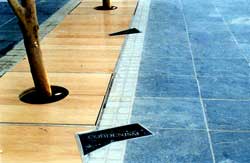Windfall 2001

2001
Nedcor headquarter building, Sandton
Material: Zimbabwe Black and Rustenburg Grey granite.
Processing of granite: Boschpoort granite, Belfast, Mpumalanga
My work WINDFALL occupies the walking areas of the main foyer of the new NEDCOR building in
Sandton, Johannesburg - a little more than half a football field in size. The work is situated
on different floor-levels as accessed through the main entrance and developing along the
escalators onto higher levels.
I have chosen the name WINDFALL, a name that plays on other, rather romantic words like
rainfall and snowfall where one may actually see the visual effects of a natural falling.
A windfall, in its original sense, is something blown down by the wind - a branch, a fruit,
often something useful or tasty. In fact a windfall has come to denote a lucky find, a
valuable coin in the road, an unexpected benefit in business, a fortuitous earning or
surprising profit.
The coming up and dying down of wind underlie the rising and falling of investment
opportunities, and the unseen nature of wind is in keeping with the abstract nature of
monetary concerns. Like the winds they can be flexible, flighty, unexpected or enduring.
Wind operates in the same safe or risky trajectories as the routes along which the investor
and entrepreneur navigate the ship of their expectations and resources. The strength and
potential of these forces are constantly assessed should they turn out to be sudden blasts,
slight breezes or strong currents. As with the venture of financial assets, the wind carries
with it elements of surprise and unpredictability in need of informed management. Although the
wind "bloweth where it listeth" it can be expertly harnessed.
Wind is as universal as the chance to turn sleeping opportunities to gain. It is everywhere,
and in every place its unique make-up offers the moment that can be seized for fortune or ruin.
The seasoned investor knows that fiscal breezes bring rain or snow. Wind propels the windmill
and distributes the pollen of flowers, but it can also work havoc and cause disastrous tragedy.
Each wind has a predictability or 'style' all of its own but it can also have 'mood-swings'
and a capriciousness that makes depending on it a nightmare. The French philosopher Claude
Lévi-Strauss refers to policies of random endeavour as a "contingency of the incidental and
the coincidental."
To install WINDFALL I sandblasted 160 unfamiliar words, eighty for winds and eighty for
issues of monetary concern, onto different odd-shaped rectilinear flagstone blocks of
granite - to capture the most fugitive element within the most concrete - 'wind' on stone.
The 160 arcane names of winds and economic terms were selected from my dictionary of
difficult English containing over 18,000 entries. The winds are sandblasted in shiny
black lettering onto a grey granite and the monetary terms in grey lettering onto a shiny
black granite. The strange words must create the idea of messages on scraps of paper carried
in from above and beyond. The stones have accidental shapes, almost like clumsy snow-crystals
and are scattered across the floor of the walking area as if blown in by the wind - like
sparsely shed leaves under a tree, or like thinly sprinkled salt on food - a windfall.
To give WINDFALL a universal feel, winds from all over the world are laid down on the floor.
Wind tends to ignore man-made boundaries almost in the same way as the financial wizard
adventurously courts good fortune in far-away places. The wind is often hard to understand
and so is the world of finance. Preference is given to names like MELTEMI (a north-west wind
in Turkey and Greece), EURUS (the east-wind), AFER (a south-west wind), PHEFO (Northern Sotho
for wind), UMOYA (wind in the Nguni Languages of South Africa), EMBAT (a wind that blows from
Turkey across Egypt) and KATABURAN (a hot, miserable wind in Asia).
I the eighty words related to the economy are as perplexing as those for winds. These arcane
words are brain-teasers, lying around for someone to unravel. Luck plays a part in selecting
a sound investment portfolio, but it is after all the genius who is able to decode, the one
who figures things out, who will make the most intelligent and salient choice. Words like
OLIGOPOLY (a market dominated by few sellers and many producers), UMKHOKHI (Zulu for one who
makes payments) QUOMODOCUNCIZATION (the making of money in any possible way) and CAPELOCRACY
(the rule of retail dealers), are used.
WINDFALL is made accessible to visitors by a touch-screen computer installed in the vicinity.
It provides a brief explanation of the work and the abstruse words with their definitions are
also given.
A view of the atrium of the Nedcor headquarter building in Sandton, Johannesburg. The
individual flagstones of WINDFALL are encountered casually and close-up as people walk
around. One can also see the work from a distance by standing on one of the many bridges
spanning the atrium at both ends.
Willem Boshoff in his studio. The flagstones and their words were first made as chipboard
replicas. To prevent breakages during the building's construction, these dummies were
laid precisely into the floor and later replaced.
An illustration of the random layout of tiles on the Nedcor headquarter floor. The dark
tiles suggest financial terms and the light tiles the names of the winds off the world.
Right hand page, top left: The dummy for feng being laid in the floor.
Right hand page, top right: The tile for feng finally laid down and cleaned up. Feng is the Chinese word for 'wind' - we may recognise it in the name of the popular earth cult feng shui which means 'wind water'.
Right hand page, bottom: Some tiles along the tree-lined walkway. Note how the tiles here overlap different surfaces of slate, ceramic tile and wood.
WINDFALL
|